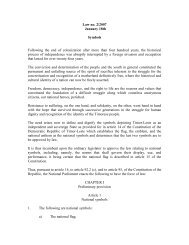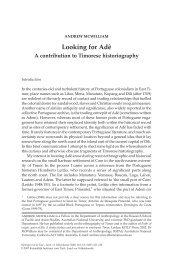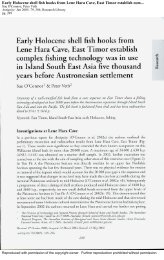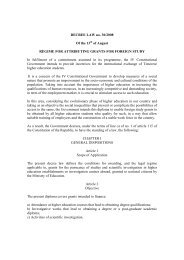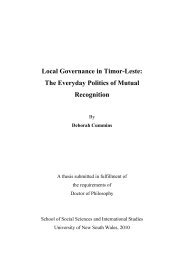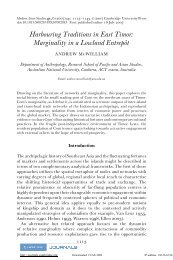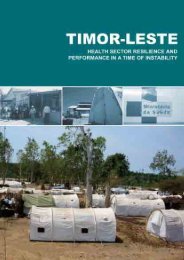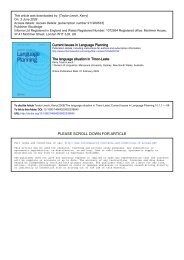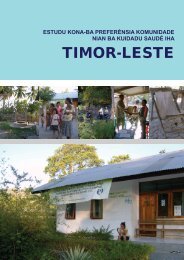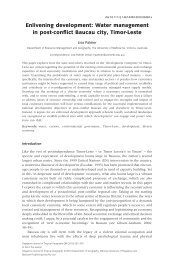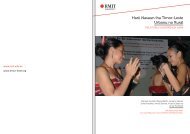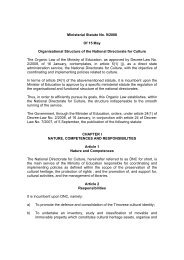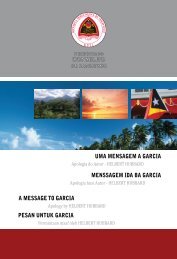1.3.2 <strong>Timor</strong>-<strong>Leste</strong> Survey of Living Standards 2007The <strong>Timor</strong> <strong>Leste</strong> Survey of Living Standards (TLSLS) [6] was carried out to build on the mo<strong>de</strong>st livingstandards survey that had formed part of the Poverty Assessment in 2001. The TLSLS had twocomponents, a cross-sectional sample of 4500 households, and a ‘panel’ component which followedup half (900) of the households surveyed in 2001. The cross-sectional survey drew on the samplingframe provi<strong>de</strong>d by the 2004 Census and collected economic and social data from a nationallyrepresentative sample drawn from five regions across the country. The health module inclu<strong>de</strong>dseveral questions on health seeking and health services utilisation, thus supplying baselinehousehold-level data on these behaviours and their correlates. Other health data collected in theTLSLS inclu<strong>de</strong>d those issues related to immunisation, bednet use, birth spacing and pregnancy/childbirth.1.3.3 <strong>Timor</strong>-<strong>Leste</strong> <strong>Health</strong> <strong>Care</strong> <strong>Seeking</strong> <strong>Behaviour</strong> <strong>Study</strong> 2008The HCSBS incorporated both a quantitative (survey) and a qualitative component.The HSCBS survey sample was drawn from the TLSLS sample. This offered opportunities to link HCSBSdata with social data collected previously in the TLSLS. The HCSBS covered different domains ofhealth-seeking, and expan<strong>de</strong>d on some domains inclu<strong>de</strong>d in the TLSLS. In particular, given thenational focus on achieving the MDG targets, maternal and child health issues were prioritised.Unlike the TLSLS, the HCSBS survey sample was not <strong>de</strong>signed to be nationally representative but,rather, to be typical of rural areas that are without ready access to hospitals.The qualitative component of the HCSBS allowed exploration of the processes, beliefs andbehaviours associated with health problems in or<strong>de</strong>r to better un<strong>de</strong>rstand the factors influencinghealth care seeking.Figure 1, below, shows the relationship between the Census, TLSLS and HCSBS.<strong>Timor</strong>-<strong>Leste</strong> <strong>Health</strong> <strong>Care</strong> <strong>Seeking</strong> <strong>Behaviour</strong> <strong>Study</strong> | 2009Married menquestionnaire2004<strong>Timor</strong>-<strong>Leste</strong> Census ofPopulation and Housing2007<strong>Timor</strong>-<strong>Leste</strong> Survey ofLiving StandardsHEALTHFigure 1 - Research context2008<strong>Timor</strong>-<strong>Leste</strong> <strong>Health</strong> <strong>Care</strong> <strong>Seeking</strong> <strong>Behaviour</strong> <strong>Study</strong>SurveyHousehold headquestionnaireMarried womenquestionnaireSince In<strong>de</strong>pen<strong>de</strong>nce:Qualitative research andsurveys by NGOs and otherstakehol<strong>de</strong>rsService userinterviewsQualitativeService userFGDsProvi<strong>de</strong>rinterviews15
Capacity enhancementCollaboration and capacity building were emphasised throughout the HCSBS. The survey was carriedout by the National Statistics Directorate (part of the Ministry of Finance), providing an opportunityto enhance links between it and the MOH. In addition, UNSW advertised for a local <strong>Timor</strong>eseresearch organisation that would take responsibility, with UNSW support, for the qualitativefieldwork and collaboration on the analysis. Following a competitive ten<strong>de</strong>r process, the AlolaFoundation was selected and provi<strong>de</strong>d the base for the qualitative team and the <strong>Timor</strong>ese SeniorResearcher. All training and research activities were <strong>de</strong>signed as opportunities for further skills<strong>de</strong>velopment and institutional strengthening. Survey structure and fieldwork was led by theNational Statistics Directorate, and qualitative fieldwork and data collection by the team based at theAlola Foundation. UNSW managed the process through the Project Directors (Prof Anthony Zwi andDr Ilse Blignault), Project Manager (Ms Cynthia Grant), Project Coordinator (Mr Basilio Martins Pinto)and Data Specialists (Dr Diana Glazebrook and earlier, Dr Catherine Bateman Steel).1Section 2 – Literature Review2.1 – International researchA literature review conducted in preparation for the HCSBS aimed to consi<strong>de</strong>r similar research thathad been carried out in other settings and to gain an un<strong>de</strong>rstanding of the theoretical andmethodological issues un<strong>de</strong>rpinning research in this field. Articles and papers reporting studies onhealth care seeking in <strong>de</strong>veloping countries were reviewed, with a focus on those that <strong>de</strong>alt withissues highlighted as important in <strong>Timor</strong>-<strong>Leste</strong>.The bulk of health care seeking studies around the world have been <strong>de</strong>scriptive, providing anoverview of the patterns of behaviour and the choices people make in relation to their health andthe services with which they interact. Some studies, particularly those which inclu<strong>de</strong>d a qualitativeelement, also offered explanations as why certain choices are ma<strong>de</strong> or certain behaviours occur;however many of them were limited to a specific illness or health topic.Generally, patterns of health service utilisation and health care seeking were influenced by socioeconomicstatus, maternal education, and cultural beliefs and perceptions of the causes, and scopefor treating, different conditions. The main barriers to service utilisation were reported as longdistances and poor transportation, health service factors such as staff attitu<strong>de</strong>s and hours ofoperation, and the assessment of the benefits and costs by community members associated with useof available services.TB, malaria and diarrhoea were commonly investigated [27-40], and some patterns of behaviourwere similar across countries and settings. For malaria and TB, for example, home treatment was acommon first step and only after this failed was help sought outsi<strong>de</strong> the home [30, 34]. Delay intreatment for diarrhoea was mainly related to lack of recognition of severity [28]. Rural living was aconsistently a barrier to engagement with services, although this was not always simply a function ofdistance [41]. Factors such as lack of information and other health service factors also played a role.1 Further information about the capacity-building aspects of this <strong>Study</strong> can be found in the HSCBS Project Report.<strong>Timor</strong>-<strong>Leste</strong> <strong>Health</strong> <strong>Care</strong> <strong>Seeking</strong> <strong>Behaviour</strong> <strong>Study</strong> | 200916



